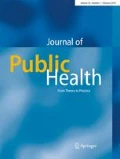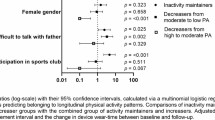Abstract
Aim
The aim of this study was to examine whether the correlates of physical activity (PA) differed as a function of two different PA recommendations: (1) the Fitness Recommendation, i.e., the improvement of cardiovascular fitness by 3 × 20 min/week of vigorously intense PA and (2) the health-enhancing PA (HEPA) concept such as the emphasis on the important benefits to health and fitness by performing 5 × 60 min/week of moderately intense PA.
Subjects and Methods
A cross-sectional design was used. In a sample of 524 adolescents (50.2% males, mean age = 15.0), we quantified different (demographic/biological, psychological, behavioural) self-reported correlates of PA as well as compliance with the PA recommendations. Sex-specific multivariate logistic regression models were used to identify correlates of fulfiling the two PA recommendations.
Results
Multivariate analyses revealed differences between the correlates and PA-specific Recommendations. For boys, only the Fitness Recommendation was significantly associated with psychosocial variables (self-efficacy and behavioural change strategies) and membership in a sports club. For girls, membership in a sports club was significantly associated with both PA recommendations. However, this association was positive with respect to the Fitness Recommendation and negative with respect to the HEPA Recommendation.
Conclusion
Our results provided some preliminary indication that correlates differ depending on specific recommendations in 14–16-year-old boys and girls. Moreover some variability with regard to sex was observed.
Similar content being viewed by others
References
Ball K, Timperio AF, Crawford DA (2006) Understanding environmental influences on nutrition and physical activity behaviors: where should we look and what should we count? Int J Behav Nutr Phys Act 3:33
Biddle SJH (2007) Sedentary behavior. Am J Prev Med 33:502–504
Biddle SJH, Whitehead SH, O'Donavon TM, Nevill ME (2005) Correlates of participation in physical activity for adolescent girls: a systematic review of recent literature. J Phys Act Health 2:423–434
Bös K, Heel J, Romahn N, Tittlbach S, Woll A, Worth A, Hölling H (2002) Untersuchungen zur Motorik im Rahmen des Kinder-und Jugendsurveys. Gesundheitswesen 64:S80–S87
Brodersen NH, Steptoe A, Williamson S, Wardle J (2005) Sociodemographic, developmental, environmental, and psychological correlates of physical activity and sedentary behavior at age 11 to 12. Ann Behav Med 29:2–11
Brodersen NH, Steptoe A, Boniface DR, Wardle J (2007) Trends in physical activity and sedentary behaviour in adolescence: ethnic and socioeconomic differences. Br J Sports Med 41:140–144
Bucksch J, Finne E, Kolip P (2008) Transtheoretical model in the context of physical activity in a school-based sample of German adolescents. Eur J Sport Sci 8:403–412
Cavill N, Biddle S, Sallis JF (2001) Health enhancing physical activity for young people: statement of the United Kingdom expert consensus conference. Pediatr Exerc Sci 13:12–25
Cole TJ, Bellizzi MC, Flegal KM, Dietz WH (2000) Establishing a standard definition for child overweight and obesity worldwide: international survey. BMJ 320:1240–1243
Cooper AR, Andersen LB, Wedderkopp N, Page AS, Froberg K (2005) Physical activity levels of children who walk, cycle, or are driven to school. Am J Prev Med 29:179–184
Currie C, Samdal O, Boyce W, Smith R (2001) Health behaviour in school-aged children: a WHO cross-national study (HBSC), research protocol for the 2001/2002 survey. Child and Adolescent Health Research Unit. University of Edinburgh, Edinburgh
Currie C, Roberts C, Morgan A, Smith R, Settertobulte W, Samdal O, Barnekow Rasmussen V (eds) (2004) Young people’s health in context. Health Behaviour in School-aged Children (HBSC) study: international report from the 2001/2002 survey. WHO Regional Office for Europe, Copenhagen
De Bourdeaudhuij I, Teixeira PJ, Cardon G, Deforche B (2005) Environmental and psychosocial correlates of physical activity in Portuguese and Belgian adults 12. Public Health Nutr 8:886–895
Ekelund U, Sardinha LB, Anderssen SA, Harro M, Franks PW, Brage S, Cooper AR, Andersen LB, Riddoch C, Froberg K (2004) Associations between objectively assessed physical activity and indicators of body fatness in 9- to 10-year-old European children: a population-based study from four distinct regions in Europe (the European Youth Heart Study). Am J Clin Nutr 80:584–590
Fuchs R, Schwarzer R (1994) Selbstwirksamkeit zur sportlichen Aktivität: Reliabilität und Validität eines neuen Messintruments. Zeitschrift für Differentielle und Diagnostische Psychologie 15:141–154
Giles-Corti B, King AC (2009) Creating active environments across the life course: “thinking outside the square”. Br J Sports Med 43:109–113
Idler EL, Benyamini Y (1997) Self-rated health and mortality: a review of 27 community studies. J Health Soc Behav 38:21–37
Jago R, Anderson CB, Baranowski T, Watson K (2005) Adolescent patterns of physical activity differences by gender, day, and time of day. Am J Prev Med 28:447–452
Kromeyer-Hauschild K, Wabitsch M, Kunze D (2001) Perzentile für den Body Mass Index für Kinder im Alter von 0 bis 18 Jahren. Monatszeitschrift Kinderheilkunde 149:807–818
Lampert T, Mensink GB, Romahn N, Woll A (2007) Physical activity among children and adolescents in Germany. Results of the German Health Interview and Examination Survey for Children and Adolescents (KiGGS). Bundesgesundheitsblatt Gesundheitsforschung Gesundheitsschutz 50:634–642
Lewis BA, Marcus BH, Pate RR, Dunn AL (2002) Psychosocial mediators of physical activity behavior among adults and children. Am J Prev Med 23:26–35
Maddison R, Prapavessis H (2006) A longitudinal examination of exercise behavior among New Zealand adolescents: a test of the transtheoretical model. Pediatr Exerc Sci 18:351–363
Olds T, Ridley K, Wake M, Hesketh K, Waters E, Patton G, Williams J (2007) How should activity guidelines for young people be operationalised? Int J Behav Nutr Phys Act 4:43
Owen N, Humpel N, Leslie E, Bauman A, Sallis JF (2004) Understanding environmental influences on walking; Review and research agenda. Am J Prev Med 27:67–76
Pate RR (2007) Historical perspectives on physical activity, fitness, and health. In: Bouchard C, Blair SN, Haskell WL (eds) Physical activity and health. Human Kinetics, Champaign, pp 22–35
Pate RR, Freedson PS, Sallis JF, Taylor WC, Sirard J, Trost SG, Dowda M (2002) Compliance with physical activity guidelines: prevalence in a population of children and youth. Ann Epidemiol 12:303–308
Patterson E, McGeough D, Cannon E, Hagströmer M, Bergman P, Kearney J, Sjöström M (2006) Self-efficacy, stages of change, physical activity in Irish college students. J Public Health 14:81–86
Prochaska JO, Velicer WF (1997) The transtheoretical model of health behavior change. Am J Health Promot 12:38–48
Prochaska JJ, Sallis JF, Long B (2001) A physical activity screening measure for use with adolescents in primary care. Arch Pediatr Adolesc Med 155:554–559
Rhodes RE, Berry T, Naylor P-J, Wharf Higgins SJ (2004) Three-step validation of exercise behavior processes of change in an adolescent sample. Meas Phys Educ Exerc Sci 8:1–20
Richter M (2005) Gesundheit und Gesundheitsverhalten im Jugendalter: Der Einfluss sozialer Ungleichheit. VS-Verlag, Wiesbaden
Richter M, Settertobulte W (2003) Gesundheits-und Freizeitverhalten von Jugendlichen. In: Hurrelmann K, Klocke A, Melzer W, Ravens-Sieberer U (eds) Jugendgesundheitssurvey. Internationale Vergleichsstudie im Auftrag der Weltgesundheitsorganisation WHO. Juventa, Weinheim, pp 99-157
Sallis JF (2000) Age-related decline in physical activity: a synthesis of human and animal studies. Med Sci Sports Exerc 32:1598–1600
Sallis J, Patrick K (1994) Physical activity guidelines for adolescents: consensus statement. Pediatr Exerc Sci 6:302–314
Sallis JF, Saelens BE (2000) Assessment of physical activity by self-report: status, limitations, and future directions. Res Q Exerc Sport 71:S1–S14
Sallis JF, Prochaska JJ, Taylor WC (2000) A review of correlates of physical activity of children and adolescents. Med Sci Sports Exerc 32:963–975
Sherry B, Jefferds ME, Grummer-Strawn LM (2007) Accuracy of adolescent self-report of height and weight in assessing overweight status: a literature review. Arch Pediatr Adolesc Med 161:1154–1161
Spink KS, Shields CA, Chad K, Odnokon P, Muhajarine N, Humbert L (2006) Correlates for structured and unstructured activity among sufficiently active youth and adolescents: a new approach to understanding physical activity. Pediatr Exerc Sci 18:203–215
Strong WB, Malina RM, Blimkie CJ, Daniels SR, Dishman RK, Gutin B, Hergenroeder AC, Must A, Nixon PA, Pivarnik JM, Rowland T, Trost S, Trudeau F (2005) Evidence based physical activity for school-age youth. J Pediatr 146:732–737
Tabachnick BG, Fidell LS (2007) Using multivariate statistics. Pearson Education, Boston
Timperio A, Ball K, Salmon J, Roberts R, Giles-Corti B, Simmons D, Baur LA, Crawford D (2006) Personal, family, social, and environmental correlates of active commuting to school. Am J Prev Med 30:45–51
Twisk JW (2001) Physical activity guidelines for children and adolescents: a critical review. Sports Med 31:617–627
Van Sluijs EM, McMinn AM, Griffin SJ (2007) Effectiveness of interventions to promote physical activity in children and adolescents: systematic review of controlled trials. BMJ 335:703–716
Vilhjalmsson R, Kristjansdottir G (2003) Gender differences in physical activity in older children and adolescents: the central role of organized sport. Soc Sci Med 56:363–374
Wickel EE, Eisenmann JC (2007) Contribution of youth sport to total daily physical activity among 6- to 12-year-old boys 2. Med Sci Sports Exerc 39:1493–1500
Acknowledgements
This study was financially supported by a grant from the University of Bremen.
Competing Interests
The authors declare that they have no competing interests.
Author information
Authors and Affiliations
Corresponding author
Rights and permissions
About this article
Cite this article
Bucksch, J., Fuhrmann, H. Correlates of two different physical activity recommendations in a German sample of 14–16-year-old boys and girls. J Public Health 18, 413–423 (2010). https://doi.org/10.1007/s10389-010-0319-9
Received:
Accepted:
Published:
Issue Date:
DOI: https://doi.org/10.1007/s10389-010-0319-9




